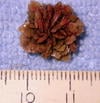 "Blackie" is seven years old. For the last two years he has had recurring urinary problems. Every couple of months, he’d have an episode of having to "go out" frequently; he would strain to pass small volumes of urine, and there would be noticeable blood in the urine. His previous doctor treated him with amoxicillin, which seemed to resolve the problem after four or five days of treatment. Of course, if the problem is happening every two months, it would be stretching things a bit to say that it was "resolved".
"Blackie" is seven years old. For the last two years he has had recurring urinary problems. Every couple of months, he’d have an episode of having to "go out" frequently; he would strain to pass small volumes of urine, and there would be noticeable blood in the urine. His previous doctor treated him with amoxicillin, which seemed to resolve the problem after four or five days of treatment. Of course, if the problem is happening every two months, it would be stretching things a bit to say that it was "resolved".
The first thing we do is get a urine specimen for analysis (one of my favorite contractions is urinalysis). This might show protein (often an evidence of inflammation), sugar (if you had diabetes), ketones (if you are in terribly advanced diabetes), good or poor concentrating ability, blood (infections, tumors), white blood cells (infections), casts (little globs of gunk from your sick kidneys), tumor cells (if you have a tumor), or crystals (if you have a stone in your bladder).
If there is evidence of a problem, we want to further evaluate the bladder with an ultrasound. This allows us to look at the thickness of the bladder wall, plus you can see blood clots and stones. An X-ray will show many stones, but not all, and you can’t tell a thing about the bladder wall, blood clots or tumors.
If there is evidence of infection, the ideal thing to do is to perform a cystocentesis (putting a needle into the bladder) to get a specimen of urine for culture. This sounds a lot worse than it is. Most dogs and cats do not require any sedation at all to put a small needle into the bladder. You want to do this so that the urine sample is not contaminated by its trip to the outside. Sending the urine to the lab for culture tells you what type of bacteria you’re dealing with (or if there are any bacteria), plus it tells you which medicine will be most effective in fighting it. We could just start the patient on an antibiotic at random, but if we guess wrongly, we’re going to lose a lot of time when we have to start over again (to say nothing of prolonging the pet’s discomfort).
It’s important to have an appropriate medication, as treating bladder infections requires at least two weeks of therapy. When the bladder is empty, its lining collapses into a lot of folds. This creates many nooks and crannies for the bacteria to hide in. You have to treat for quite a while to eliminate them.
Which brings us back to Blackie. Had his previous treatments just been too short-lived, or was there some other factor that had not been detected? Having a bladder problem every two months is not normal by any stretch of the imagination.
"Has Blackie ever had an X-ray or Ultrasound or culture?" Gee, no he hasn’t. Well, since his urine is so full of blood that we can’t see anything else in it, let’s do an ultrasound. The ultrasound showed me the story, but the X-ray makes a better picture.
 When you can read your own X-rays, you know you’ve got trouble. Blackie’s owner had no difficulty in identifying the bladder stone. My photograph turned out a little blurry, but the X-ray is very sharp, as are the little spikes on the stone. Ouch!
When you can read your own X-rays, you know you’ve got trouble. Blackie’s owner had no difficulty in identifying the bladder stone. My photograph turned out a little blurry, but the X-ray is very sharp, as are the little spikes on the stone. Ouch!
 And here’s the little jewel removed at surgery. Ouch, again. The lining of the bladder had callus-like growths where it was trying to protect itself from this 15mm cockleburr-like mass of crystals. Some of the bladder lining looked like raw hamburger.
And here’s the little jewel removed at surgery. Ouch, again. The lining of the bladder had callus-like growths where it was trying to protect itself from this 15mm cockleburr-like mass of crystals. Some of the bladder lining looked like raw hamburger.
Some stones are caused by dietary or metabolic problems, others are secondary to chronic bladder infections. We’ll be sending this one to the lab to find out what it is, and how to keep a new one from forming.
This is why I like to take an X-ray on the first visit when a patient has bladder problems. Two years is kind of a long time to let something like this rattle around. Ouch, again.


nice site..